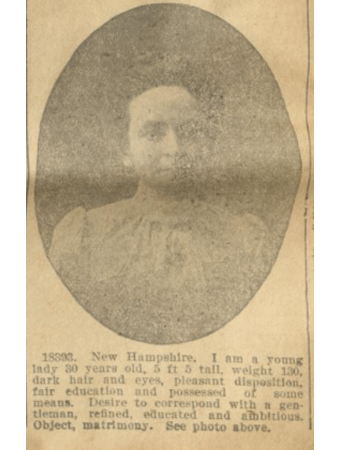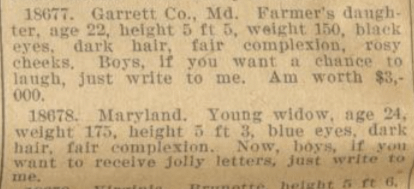
Students Get Personal at the Nabb Center
 Each semester, hundreds of SU students visit the Nabb Center to interact with the past through research projects, exhibits, and, in most cases, primary source immersion and analysis in the classroom. Our archivists work with professors to incorporate the Center’s rich archival collections into class exercises and assignments, with some courses making multiple class trips each semester. During these sessions, the archivists aim to make the past accessible, thought-provoking and fun by bringing out selected archival material for students to handle, study and make meaningful connections to their coursework. In recent years, one source in particular has generated a lot of discussion among students: a 1903 issue of The Pilot, a newspaper “… Devoted to the Interests of the Unmarried.”
Each semester, hundreds of SU students visit the Nabb Center to interact with the past through research projects, exhibits, and, in most cases, primary source immersion and analysis in the classroom. Our archivists work with professors to incorporate the Center’s rich archival collections into class exercises and assignments, with some courses making multiple class trips each semester. During these sessions, the archivists aim to make the past accessible, thought-provoking and fun by bringing out selected archival material for students to handle, study and make meaningful connections to their coursework. In recent years, one source in particular has generated a lot of discussion among students: a 1903 issue of The Pilot, a newspaper “… Devoted to the Interests of the Unmarried.”
Printed in Chicago by publisher John H. Harris, The Pilot sought to light the flame of distant lovers through personals advertisements. Dating and matchmaking are as old as time, with each generation experiencing some new way to find love at a distance, which isn’t lost on SU students when they first meet the Pilot newspaper. In fact, nearly every time it’s brought out for classes, students remark: “It’s like old-school Tinder!” Suddenly, the 120-year-old newspaper isn’t so intimidating to the students.
 These advertisements were written by “Ladies of Means,” “Ladies without Means” and “Gents” who were looking to correspond with each other for the primary objective of marriage, though many sought “fun and results” or even simply “amusement.” Most descriptions included location, religion, height and weight, and prior marriage status, in addition to personal details such as occupation, property value, inheritance and special domestic skills. Some even paid extra to include a photograph to accompany the ad.
These advertisements were written by “Ladies of Means,” “Ladies without Means” and “Gents” who were looking to correspond with each other for the primary objective of marriage, though many sought “fun and results” or even simply “amusement.” Most descriptions included location, religion, height and weight, and prior marriage status, in addition to personal details such as occupation, property value, inheritance and special domestic skills. Some even paid extra to include a photograph to accompany the ad.
 While this source is immediately entertaining for students, our archivists capitalize on the connection to push the students to analyze the source further, consider possible research questions and assess how they could approach the source academically. Beginning with this source, students could research topics related to courtship technology and trends, gender expectations in Edwardian America, or even a detailed sociological case with all of the ads extracted into a spreadsheet. Moreover, the collection that the newspaper comes from (the Mary Anne Pieper Collection) includes a folder of letters that were sent from women to James C. Dixon of Pocomoke City, the former owner of the issue who was seeking a wife at the time.
While this source is immediately entertaining for students, our archivists capitalize on the connection to push the students to analyze the source further, consider possible research questions and assess how they could approach the source academically. Beginning with this source, students could research topics related to courtship technology and trends, gender expectations in Edwardian America, or even a detailed sociological case with all of the ads extracted into a spreadsheet. Moreover, the collection that the newspaper comes from (the Mary Anne Pieper Collection) includes a folder of letters that were sent from women to James C. Dixon of Pocomoke City, the former owner of the issue who was seeking a wife at the time.
Last spring, one group of students in Dr. Emin Lelić’s HIST 102 (World Civilizations) course chose to use The Pilot as the centerpiece to their primary source documentary project (read about this project in a previous newsletter). In the fall, students who visited the Nabb Center for several history classes, as well as communications and honors classes, spent time analyzing The Pilot alongside other sources. And, on February 13, our archivists brought it out for the “Speed Dating with Nabb Center Collections” event where attendees “flirted with,” ranked and chose a collection to “take home” from among a selection of romantic collections curated for the event.
Learn more about the Mary Anne Pieper Collection in the finding aid or check out The Pilot issue in the Nabb Center’s digital collections.